Posted May 2, 2016
By ETTY GROSSMAN
It took Tony Goldman, the late modern American developer, three years to finally be able to enjoy the life he brought into Wynwood, now Miami’s hippest and hottest emerging neighborhood.
Until his death in 2012, Goldman spent most of a decade watching people in Wynwood, smiling at the developing arts and culture scene.
He was joined by his daughter, Jessica Srebnick, who also believed in the possibility of tuning ordinary walls into huge canvas.
Back in the 1930s with South Beach’s architectural Art Deco revolution, Miami stopped being a grandmas and shopper’s destination to become the American Riviera.
However, the city re-gained its momentum by the 2000s when Wynwood, located just a few blocks from the north part of Downtown, catch the eye of developers who initiated a gentrification process.
Gentrification refers to the arrival of wealthier and often younger group of people in an existing urban district with a related increase in rents and property values.
There are often changes in the district’s character and culture. It tends to take lots of time for these changes to happen, however, things were quite different in Wynwood.
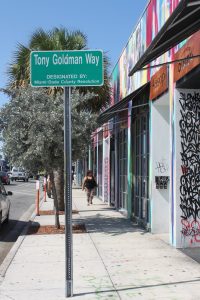
To honor Tony Goldman, a pioneer who helped establish Wynwood as an exciting arts destination, the Miami-Dade County Commission renamed the heart of Wynwood, NW 20th Street to NW 29th Street on NW 2nd Avenue, as Tony Goldman Way (Photos by Etty Grossman).
Originally spelled Wyndwood, the area was not a major attraction. Since its inception, the neighborhood was an area for working class families. By the mid 1950s, it began to be filled with Puerto Ricans attracted by the opportunities to improve their lives.
As the district got more popular, the value of commercial square footage went up and many of the manufacturers decided to move out to places like Hialeah.
Unemployment and abandonment made the place unsafe and served as the perfect scenario for periods of drug trafficking and crime.
“My first memory of Wynwood, was in the late 90s. Back then driving into what was also known as the Fashion District was somewhat of an adventure,” said Dominique Duque, the first real estate agent selected to become a member of The Riley Smith Group.
“This adventure included not wearing or taking anything of value and driving with all doors locked while looking in every direction. The vibe you got was a sad, abandoned ghost town in the middle of nowhere,” she added.
While residents challenged the county for more security measurements, the artistic initiative also started to take root.
“In 2000, when I first came to Wynwood, I liked the scale of the buildings and the width of the streets,” said David Lombardi, broker and founder of Lombardi Properties, one of the biggest boutique realty firms in Miami.
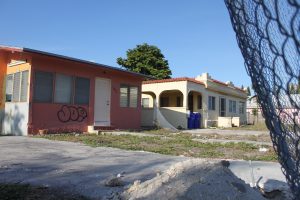
Examples of the original facade of warehouses and residences before Wynwood’s gentrification process started.
“Reality is that the area was not inviting, but I saw that amazing things could be done with the spaces. So I started getting involved with artists.”
In 2002 Art Basel, a platform for galleries to show and sell their works debuted in Miami Beach. With this improvement, people interested in arts and culture thought about Miami as the perfect destination.
“The city needed more spaces to develop the art industry,” said Victor Sanchez, senior project manager of Goldman Properties. “And Tony, our founder who had quite an eye for urban development, realized it would be advantageous to have warehouses close to Miami Beach and the Design District.”
In 2006 Goldman Properties, a force behind the revival of SoHo and South Beach began buying up chunks of Wynwood warehouse district. Lombardi Properties and other top developers like Dezer Development, LeFrak, Comras Co., among others, did the same.
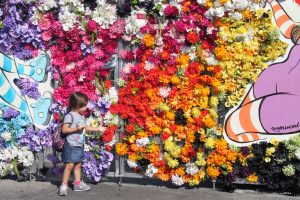
In Miami’s Wynwood Arts District, visitors can find all sorts of street art: graffiti, sculptures, wall paintings and even transformed nature.
Since that year, Wynwood has become something unique. There are now more than 70 galleries, collections, restaurants, cafes, chic shopping stores and museums. But while tourists, art lovers, foodies and hipsters enjoy the attractions, there are others who aren’t pleased with Wynwood’s gentrification.
Artists feel that their works aren’t being appreciated and they believe that developers are using art just as a marketing tool to attract people.
“The problem with Wynwood is that its history of gentrification was radically different from places like SoHo,” said Florida International University Urban Sociologist Marcos Feldman. “Here a process that takes decades occurred within years and it wasn’t led by artist, as it usually is.”
Besides the way in which things happened, generally speaking, Wynwood is maturing as a neighborhood. Fortune International Realty, a long-established real estate firm in South Florida, noticed that the total sales of acres of land sold in Wynwood in the previous five years were increased by 40 percent.
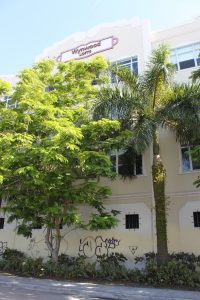
To allow artists and creatives, who helped with the transition of the neighborhood, take an ownership stake within the area, developer David Lombardi built a ground-up 36-unit live/work loft project.
“Today, lots of people want to work and live in Wynwood because of the charm of the street art and the essence of the community attitude, which is that of independence and next-generation urbanism,” explained Alfonso Ranzini, a Fortune International Realty agent. “The full activation of the neighborhood will pivot on new residences and, primarily, reasonably priced residences, which have already started to be built.”
Although gentrification is often used negatively when describing a changing neighborhood, suggesting the displacement of poor residents by wealthier outsiders, its real impact varies.
“Miami as a whole benefit greatly from an area like Wynwood because of the nature of the type of interactions that occur within the neighborhood,” said Carmen E. Rivero, vice president of Real Estate Development of MANA Wynwood, one of the largest and most innovative contemporary art organization in the area. “While other areas in Miami are centered on the high-end consumer experience, Wynwood offers an alternative, more grounded experience of culture and the arts within the city.”
While other areas, such as Little Haiti, Little Havana, Edgewater and West Coconut Grove, are considered by some as the next up-and-coming places, developers are constantly innovating and introducing elements that involve the public into Wynwood.
“In Wynwood, everything came in stages in order to make the neighborhood work,” said Victor Sanchez. “First, we dropped people in to work, then we dropped people in to entertain and now we are driving people in to live.”
To ensure a high-quality life of Wynwood’s future residents, which realtors believe would be wealthy artists and entrepreneurs between ages 25 and 35; top urban developers such as Goldman Properties, MANA Wynwood and Lombardi Properties, are currently working on many different projects.
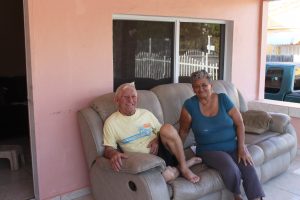
Even though gentrification has pushed away many people, original residents like Maria Otero and Dioscoride Navarro are still in the area.
For example, renovation and rehabilitation of most of the properties in Wynwood and Downtown Miami to attract and retain talent locally is underway.
There is an eight-story parking garage with commercial and office components to solve Wynwood’s parking issue in development. And a micro retail project with some office space available is another example.
Even though some locals, like Cuban immigrant Maria Otero, don’t feel threatened by the urban redevelopment of the neighborhood, Marcos Feldman explained that, for things to work, there has to be a process where all people who have a stake in Wynwood can talk to each other and negotiate with each other.
“Wynwood can become something great,” said Feldman. “Developers don’t have to stop doing what they are doing, they just have to start doing what they aren’t: thinking about locals.”
